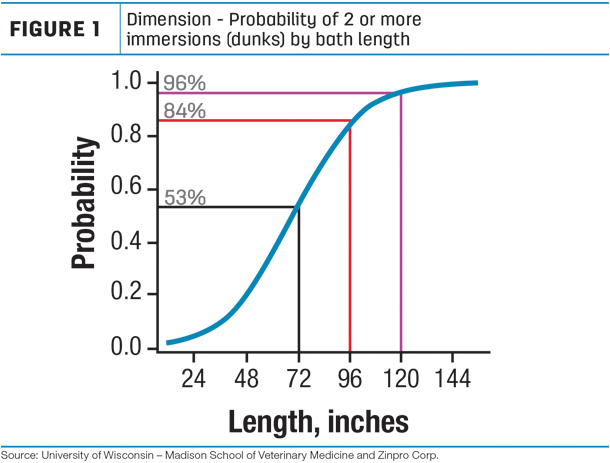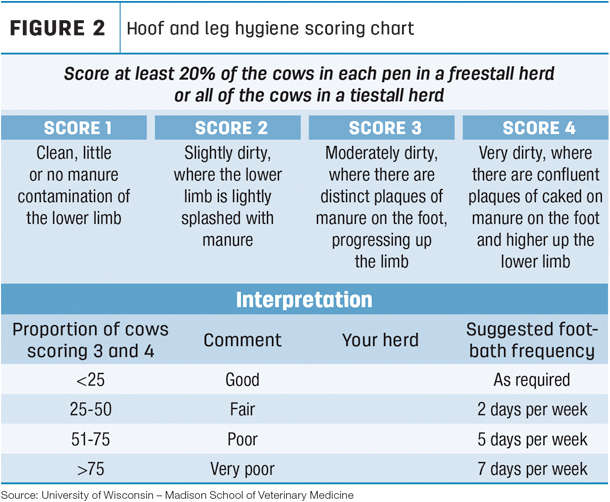No doubt that you’ve read numerous articles on footbath management, but few tell you the common mistakes that impact the success of your footbath program.
Most footbath product labels include generic management protocols, which are effective when “accurately” implemented. Although there are many points where footbath accuracy can be lost, let’s focus on the top four mistakes that are key to achieving maximum value from your footbath.
Common Mistake #1 – Water volume
Often, footbath manufacturers quote their volume based on a complete fill when placed on a level surface. To best determine the “working” volume in your footbath, the measurements should be taken with the footbath in its normal use position and filled to no more than one inch from the top at any point. This reduces sloshing in the first few cow passes, which lead to loss of volume and effective cow passes.
Product labels often provide this equation for determining your footbath volume:
Length (feet) X width (feet) X depth (feet) X 7.48 = gallons
The depth measurement should be taken at the absolute middle of the bath, as this provides the average depth.
Accurate water volume is critical for determining treatment product inclusion rate and cow passes. Placing a plastic ruler or marked measure with the correct depth next to the footbath reminds employees of the importance of accurate footbath fills and provides a quick tool to verify fill accuracy.
Common Mistake #2 – Treatment concentration
Achieving the right treatment concentration is completely reliant on knowing your footbath volume as determined above. On most farms, once the footbath volume is determined, a container is marked to indicate the amount of footbath product for that volume.
There are two potential mistakes:
-
Overfill – Adding the correct footbath product measure to an overfilled footbath results in a diluted treatment solution that is less effective for every cow walking through the bath. Common footbaths near 6 feet long calculate 10 gallons for every inch of depth. If the appropriate middle depth is 5 inches but the bath is overfilled to 6 inches, the volume increases from 50 to 60 gallons. That’s an increase of 20 percent volume, but a decrease of 20 percent treatment concentration.
- Underfill – Adding the correct amount of footbath product to an underfilled footbath produces a more concentrated footbath solution. If we use the same example as above, one inch less of middle-depth fill produces a footbath with a 20 percent decrease in volume, but an increased solution concentration greater than 20 percent. Depending on the product, this increase may produce a greater acidity (lower pH), which may be detrimental to hoof tissue. In addition, footbath contamination of manure, urine, mud, etc. is similarly concentrated, which reduces effective cow passes.
Most dairy producers and nutritionists would never accept the variation in rations that are commonly found in footbath concentrations on some of the best managed dairies.
Common Mistake #3 – Cow passes before refill
A cow pass is often defined as one cow walking through the footbath. However, was it an “effective cow pass” with the antibacterial benefit to kill harmful heel warts and foot rot bacteria?
Many footbath product labels provide a range of 300 to 500 effective cow passes based on the common 50-gallon footbath volume. Producers often accept the higher number, representing ideal management, rather than the lower number that considers common on-farm conditions and is more realistic. If the treatment cost is $25 per 50-gallon bath, 500 cow passes would cost 5 cents per cow pass compared to 8.3 cents per cow pass at 300 passes.
Some products suggest optimum pH ranges for effective cow passes. Few dairy producers monitor pH by cow pass to establish a baseline of the maximum number of passes. In addition, changes in water alkalinity can greatly impact pH ranges. If pH is used to determine footbath cow passes, it should be routinely monitored rather than accepted at the single initial measure.
Not only is the “effectiveness” of a cow pass a function of the footbath product and proper concentration, it’s also affected by the length of the footbath and the number of rear hoof immersions for each cow. Rear hoof immersion is important because 90 percent of hoof problems are on the rear hooves.
Ideally, each rear hoof should have at least two immersions. The University of Wisconsin School of Veterinary Medicine has researched footbath length with rear hoof immersions (shown in Figure 1).

A footbath length near 6 feet has just over half the probability of two or more rear immersions on each hoof, while a footbath length near 10 feet almost always has at least two immersions.
The common question is why are so many poly footbaths near 6 feet if they do not provide adequate rear hoof immersions? The answer is simple – most do not have plugs, and this length is more easily dumped and cleaned.
These shorter baths can still be very useful if placed end-to-end, providing a total footbath length near 12 feet. Producers immediately respond that this requires more treatment product and cost. This is not true. Effective cow passes are a function of footbath volume, which is doubled by using two short baths end-to-end.
Would you ever tell a producer with a 100-gallon footbath to expect the same number of effective cow passes as a producer with a 50-gallon footbath?
Common Mistake #4 – Footbath frequency
Frequency for an effective footbath program is much like teat dipping. Teat dipping does not cure mastitis, but it prevents the spread. Similarly, a footbath program should be run frequently enough to control the spread of bacterial hoof problems rather than wait for a widespread outbreak.
Footbath frequency can vary from every milking to “as-needed” based on the prevalence of heel warts or foot rot acceptable to the dairy producer. An effective footbath program results in a hoof trimmer report of less than 10 percent of the trimmed cows requiring treatment for heel warts or foot rot. The frequency needed to produce this result is based on the efficacy of the treatment product and cleanliness of the hoof and cow environment.
Dr. Nigel Cook of the University of Wisconsin School of Veterinary Medicine proposes leg hygiene (cleanliness) scoring to determine the frequency of foot bathing (see Figure 2).

If Cook’s recommended frequency does not produce acceptable hoof health in a properly prepared footbath, the product efficacy or “scheduling of treatments” should be questioned.
Scheduling of treatments refers to the chosen days of each week for treatment. It is common to hear producers say they run treatments three times a week on Monday, Wednesday and Friday. However, running the footbath on consecutive days provides a more effective bacterial kill than spanning treatments over time.
Remember, each mistake impacts the effectiveness of your dairy’s footbath program, and multiple mistakes compound the problems. Management’s best understanding of a footbath protocol and a quality product can still produce poor hoof health. Each verbal transfer or translation of the footbath program is an opportunity for misunderstanding. Written protocols are a must.
Review your footbath procedure for any of these common pitfalls. Make sure everyone knows the proper protocols, and routinely monitor that they are being followed. ![]()
References omitted but are available upon request. Click here to email an editor.
Dr. Jim Edwards has a doctorate in ruminant nutrition and is the Hoof-Zink sales and technical specialist for Sirius LLC.

-
Jim Edwards
- Hoof-Zink Sales and Technical Specialist
- Sirius LLC
- Email Jim Edwards






